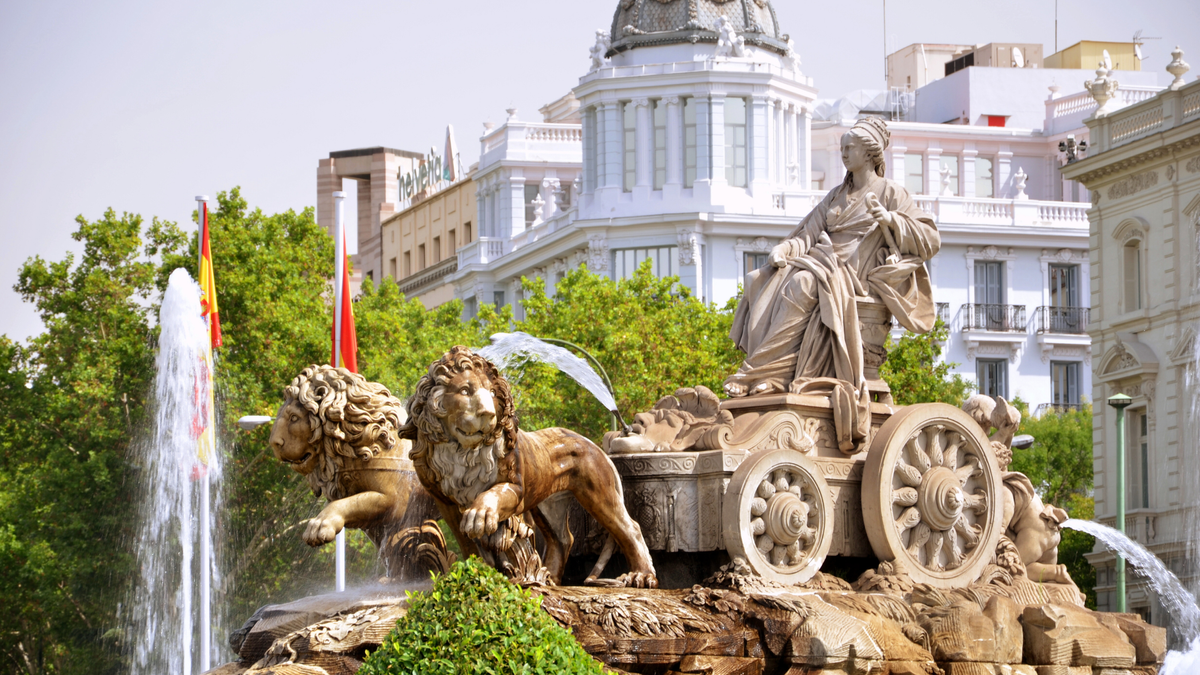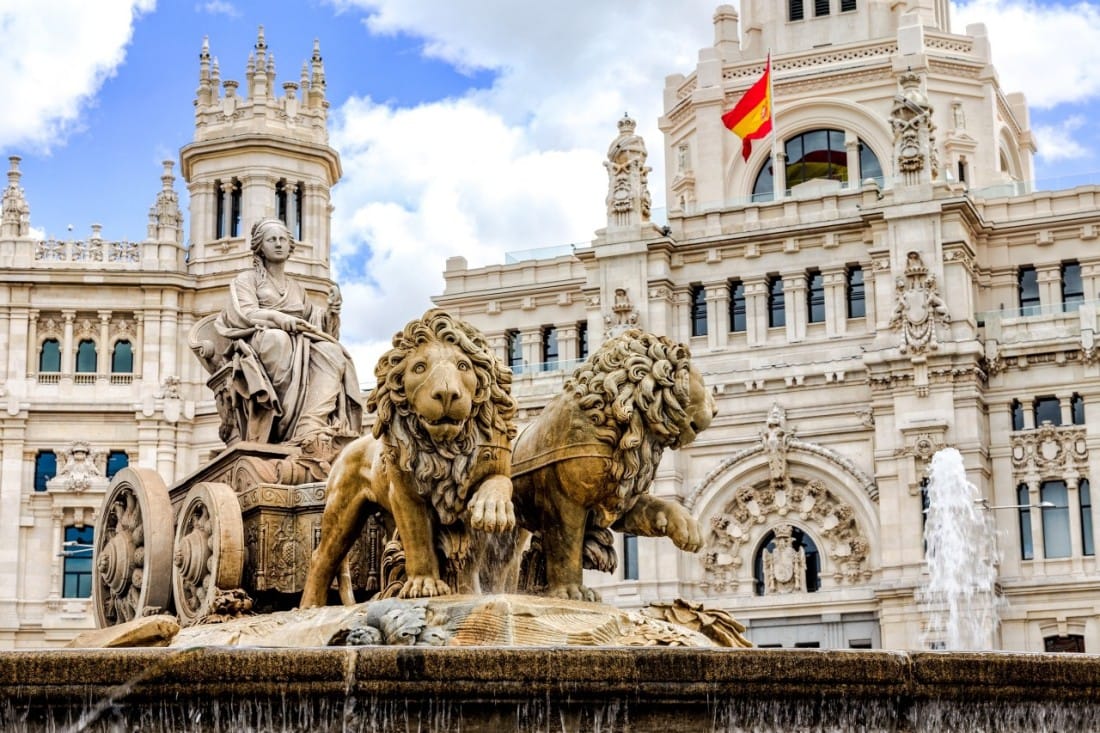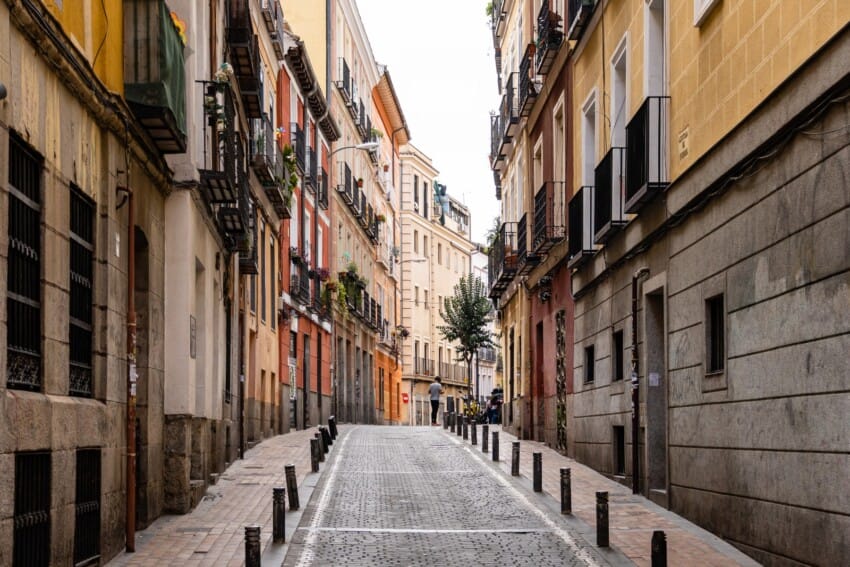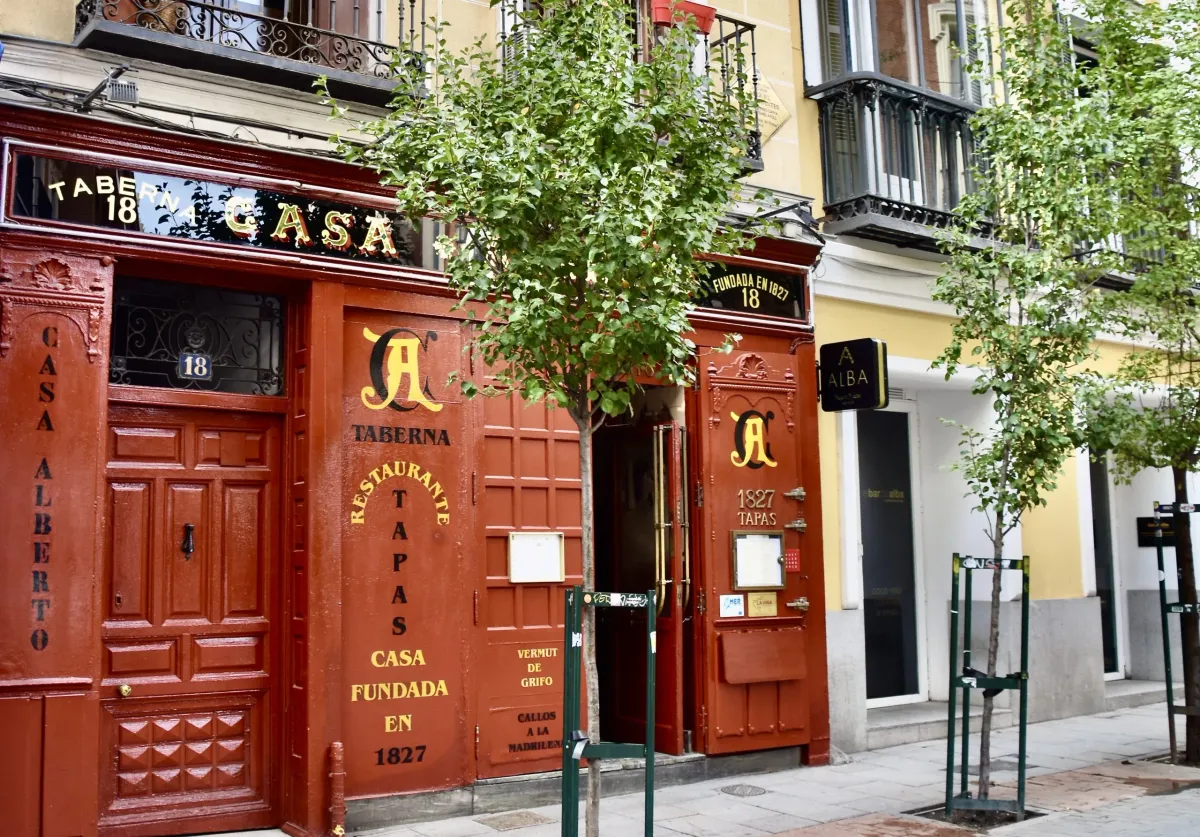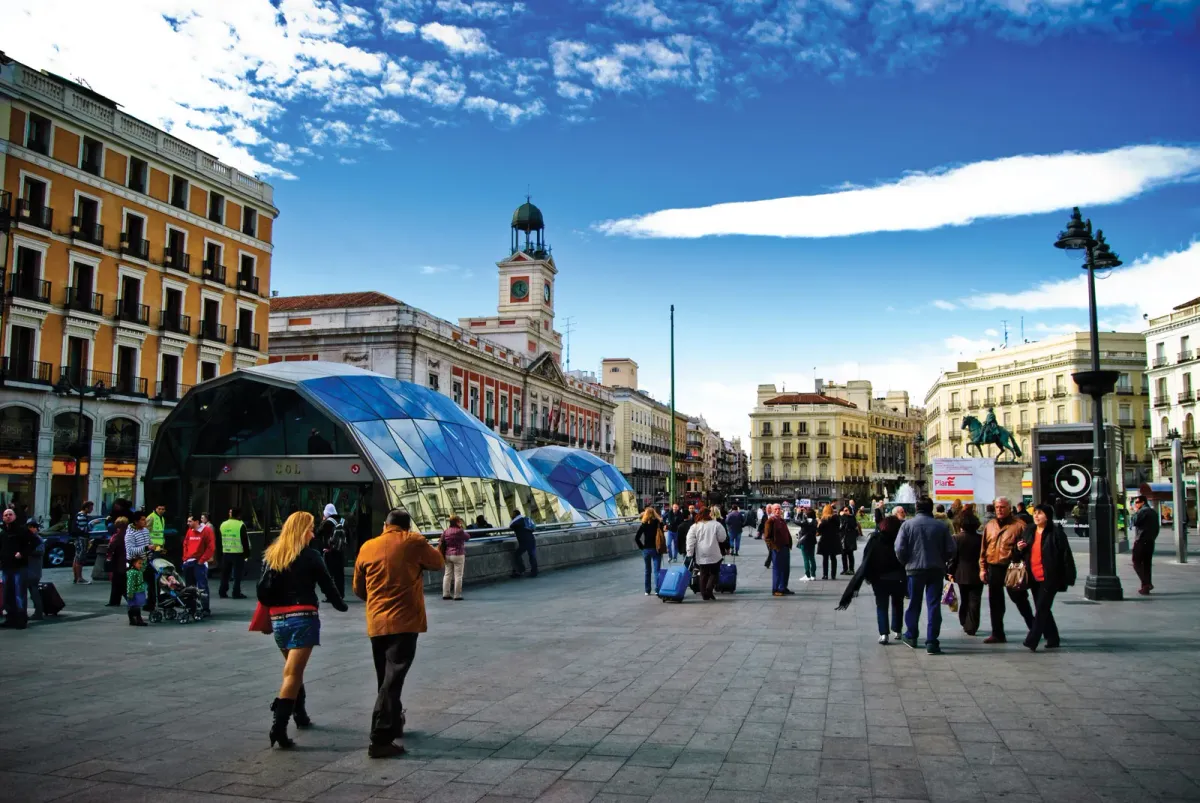Where To Stay In Madrid: Complete City Guide For Visitors
This guide will help you choose the best area of Madrid to stay in when visiting the city.
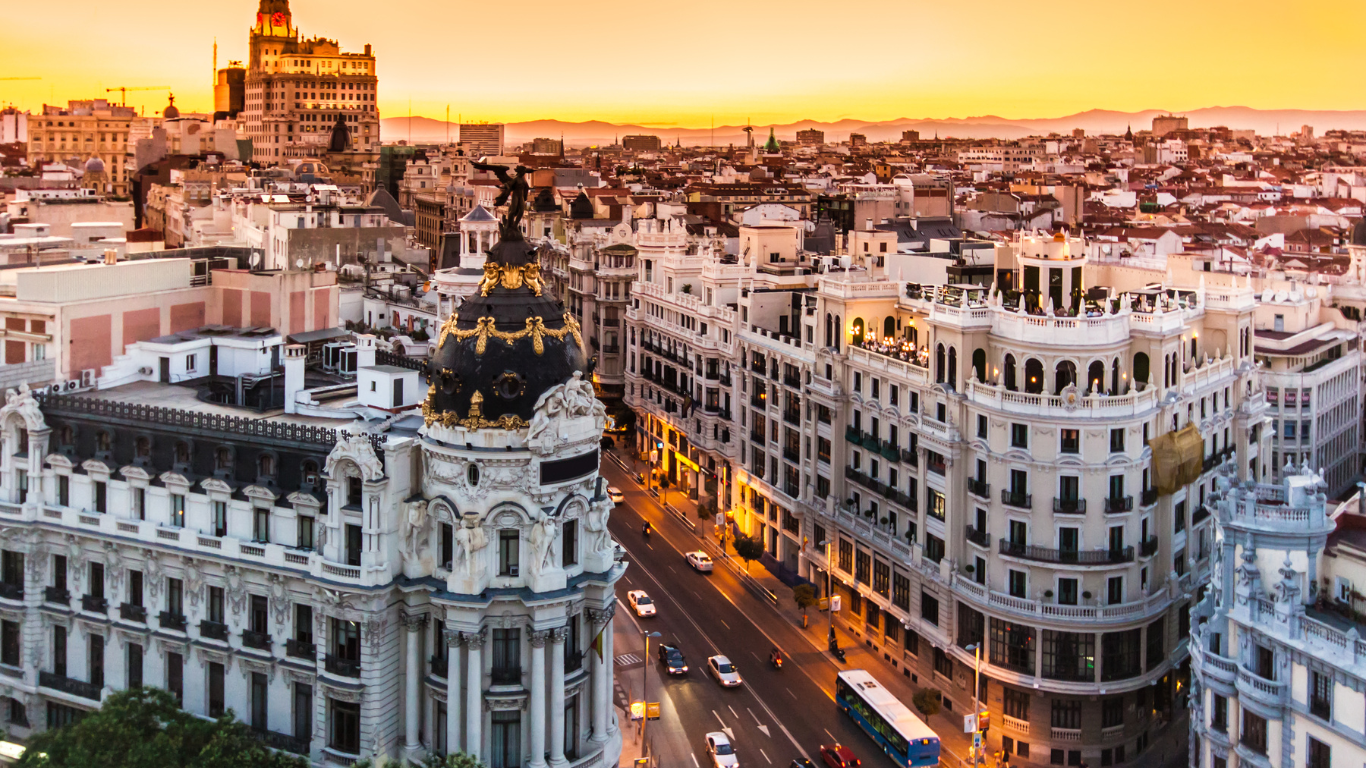
Discover Madrid's most popular districts and neighborhoods to stay in–what there is to do, and the overall experience/vibe you can expect in each area.
Centro District
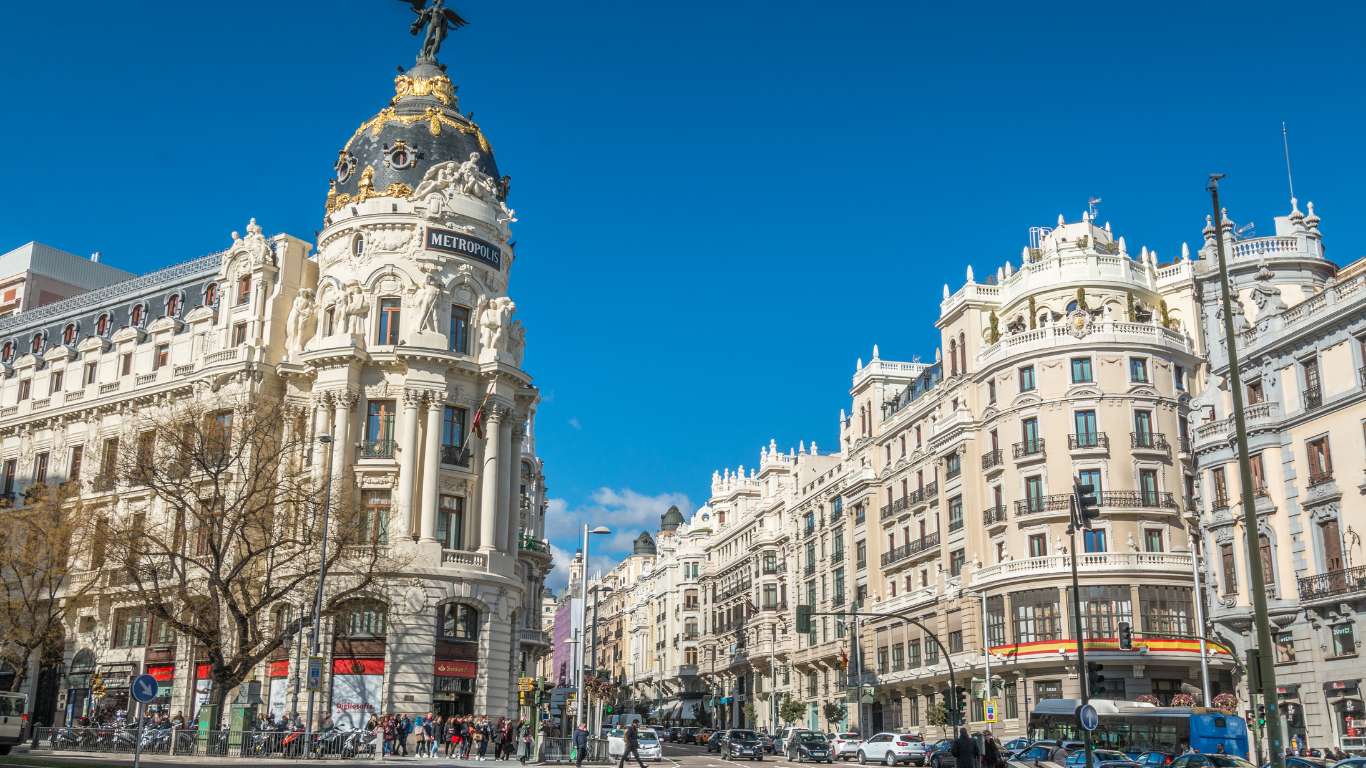
The Centro district of Madrid is the lively core of the city, and the most popular area of the city for visitors to stay. Centro holds key landmarks like Puerta del Sol, Plaza Mayor, and the Royal Palace. Centro has an abundance of theaters, museums, and galleries, and its nightlife buzzes with an array of bars and restaurants. Gran Vía and Calle de Preciados offer some of the best shopping in the city, and its central location and ease of transportation make it a popular choice for visitors.
Best for: First-time visitors, history enthusiasts, and nightlife seekers.
Best Neighborhoods In Madrid's Centro District To Stay In
Sol

Sol neighborhood is the located in the heart of Madrid, a major hub for both transport and cultural festivities. This area is essential for visitors eager to experience the pulse of city life, offering easy access to significant events and historic sites.
Gran Vía
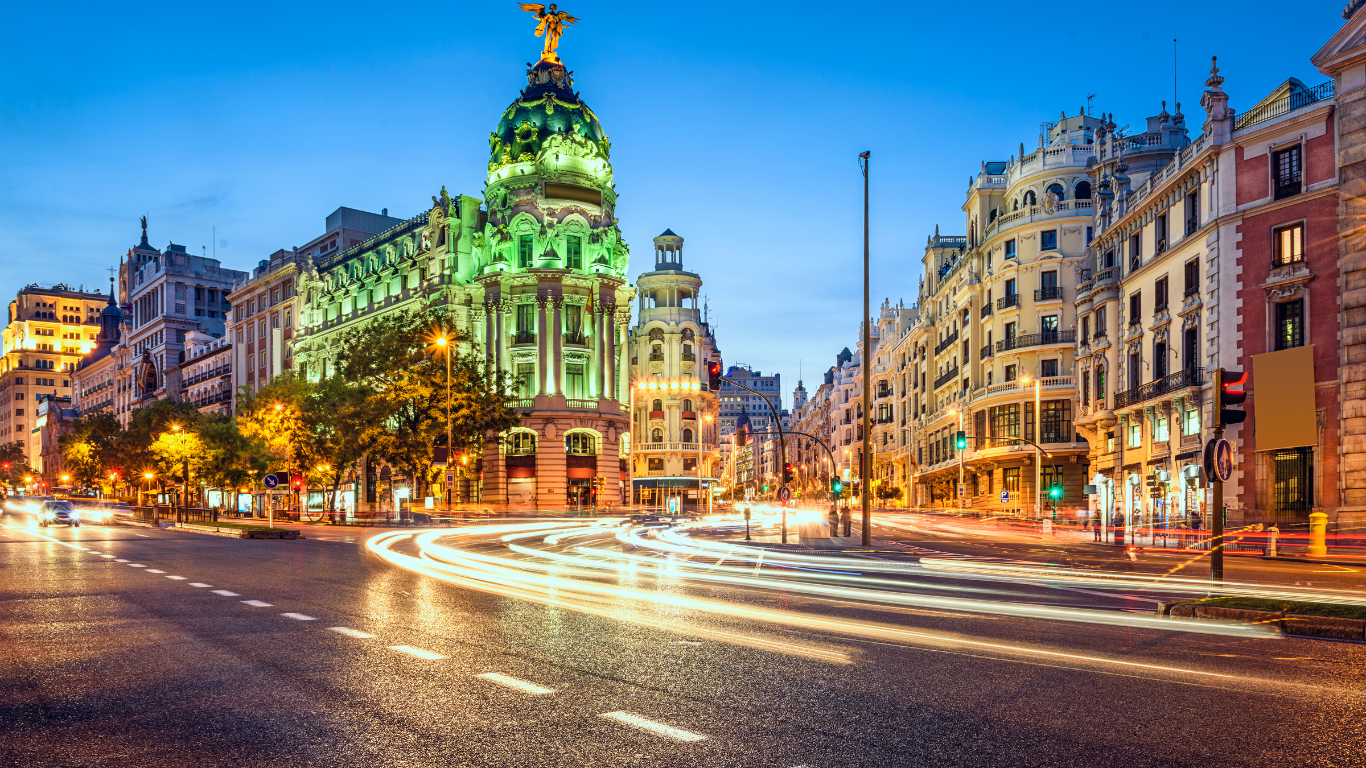
Gran Vía, Madrid's premier boulevard, is lined with theaters, shops, and iconic architecture, making it an artery of cultural and commercial activity. Ideal for those who enjoy vibrant city life and entertainment.
Barrio de las Letras

Barrio de las Letras (The Literary Quarter) is a historical neighborhood where famous literary figures once lived. It now boasts quaint cafes, antique bookshops, and perfect for those who cherish arts and history.
Malasaña

Malasaña offers a trendy, artistic vibe, with a plethora of vintage stores, eclectic cafes, and thriving nightlife, attracting a youthful and creative crowd. Malasaña is one of the most popular areas of Madrid for visitors to stay.
Barrio de La Latina

Barrio de La Latina is famous for its traditional tapas bars and rustic charm, especially during the Sunday El Rastro market. It's a cultural hub for foodies and weekend revelers, and a great area for visitors to stay.
Lavapiés

Lavapiés is celebrated for its diversity, home to a mix of cultures and global cuisines, alongside a thriving arts scene. It's a hotspot for those seeking a cosmopolitan environment. Lavapiés is a perfect area for the creative visitor due to the intricate street art that can be seen throughout the neighborhood.
Centro District Highlights
- Vibe: Historic, lively, central, trendy
- Good for: Culture enthusiasts, nightlife lovers, art lovers, first-time visitors
- Accommodation: Diverse options from luxury hotels to boutique hostels
Pros and Cons Staying In Madrid's Centro District
The Centro district of Madrid, being the heart of the city, offers a dynamic urban experience. Here are the pros and cons of staying or visiting Centro:
Pros:
- Central Location: Centro is at the very heart of Madrid, making it an ideal base for exploring the city. Major attractions, museums, and historical sites are within walking distance.
- Attractions: Visitors staying in Centro have a large portion of the cities most popular attractions and things to see, all within walking distance.
- Nightlife: Centro boasts a lively nightlife with a plethora of bars, clubs, and restaurants that cater to all tastes and preferences.
- Excellent Public Transport Links: Being the hub of Madrid, Centro offers excellent public transport connections, including metro, buses, and train services, making it easy to navigate the rest of the city.
- Diverse Shopping Options: From high-street brands on Gran Vía to unique boutiques in Malasaña, shopping in Centro is varied and abundant.
- Culinary Diversity: The area offers a wide range of dining options, from traditional Spanish tapas bars to high-end restaurants and international cuisine.
Cons:
- Crowded and Touristy: Due to its popularity and central location, Centro can be very crowded, especially during peak tourist seasons.
- Noise Levels: The vibrant nightlife and density of activities mean that noise can be an issue, particularly in areas close to major tourist spots or nightlife venues.
- Higher Cost for Everything: Being a prime area, Centro often comes with a higher cost. Overall you should expect to pay a lot more for food and lodging than in other areas of the city.
- Limited Green Spaces: Compared to other districts in Madrid, Centro has fewer parks and green spaces, which might be a downside for those seeking nature or quiet outdoor areas.
- Commercialization: Some may find that certain parts of Centro feel overly commercialized, which can detract from the authentic Spanish cultural experience.
Centro offers the excitement and convenience of city life, with easy access to many of Madrid’s best features. However, the hustle and bustle may not be for everyone, especially those looking for a quieter, more relaxed visit or living experience.
Attractions Near Centro District:
- Puerta del Sol: Central square and major hub for public transport.
- Plaza Mayor: Iconic square known for its historic architecture and vibrant atmosphere.
- Royal Palace of Madrid: Official residence of the Spanish Royal Family used for state ceremonies.
- Almudena Cathedral: Located next to the Royal Palace, a significant religious site with a blend of architectural styles.
- Gran Vía: Famous for its theaters, shopping, and bustling nightlife.
- Mercado de San Miguel: Popular market offering a variety of gourmet foods and tapas.
- Teatro Real (Royal Theatre): Renowned opera house offering high-quality performances.
- El Rastro: Famous open-air flea market, particularly lively on Sundays.
- Plaza de Oriente: Elegant square located in front of the Royal Palace, featuring gardens and statues
Salamanca District

Salamanca is the epitome of luxury and sophistication, featuring high-end boutiques and Michelin-starred dining along its pristine streets such as Calle Serrano.
Best for: Luxury shoppers, food connoisseurs, and art lovers.
Best Neighborhoods In Madrid's Salamanca District To Stay In
Recoletos

Recoletos combines peaceful, tree-lined avenues with upscale shopping, offering tranquility right next to the bustling city center.
Castellana

Castellana serves as a financial and diplomatic hub, known for its modern skyscrapers and business centers, appealing to business travelers and those interested in contemporary architecture. Castellana is also the location of some high-end shopping options.
Goya Neighborhood

Goya blends residential calm with commercial dynamism, home to luxury boutiques and cultural venues like the WiZink Center.
Salamanca District Highlights
- Vibe: Chic, sophisticated, exclusive
- Good for: High-end shopping, gourmet dining
- Accommodation: Boutique and luxury hotels
Pros and Cons Staying Madrid's Salamanca District
Visitors staying in Salamanca are sure to have an amazing time, but can have some draw backs for some visitors. Here are the pros and cons of staying or visiting Salamanca:
Pros
- High-End Shopping: Salamanca, especially along Calle Serrano, is a paradise for those looking to indulge in luxury shopping, offering flagship stores of international designer brands and upscale Spanish labels.
- Architectural Beauty: The district is noted for its impressive 19th-century architecture, providing a beautiful backdrop for walks and photos, and adding an element of grandeur to your visit.
- Cultural Offerings: Salamanca houses several prestigious museums and cultural institutions like the National Archaeological Museum and the Lázaro Galdiano Museum, enriching any cultural itinerary.
- Gourmet Dining Experience: The area boasts a variety of high-end restaurants and cafes, perfect for culinary enthusiasts looking to sample fine dining or gourmet Spanish cuisine.
- Peaceful Atmosphere: Compared to the bustling Centro, Salamanca offers a quieter and more relaxed atmosphere, ideal for visitors who prefer a less hectic environment.
- Proximity to Retiro Park: Close access to Madrid's beloved Retiro Park allows visitors to easily combine a day of shopping and sightseeing with leisurely downtime in one of the city's largest green spaces.
Cons:
- Cost: Salamanca is one of the more expensive districts in Madrid. Dining, shopping, and accommodation in this area can be quite pricey, which might not suit budget travelers.
- Nightlife: The district is not known for a vibrant nightlife scene. Those looking for lively evenings might find it too quiet, as the area lacks the variety of bars and clubs found in other parts of Madrid.
- Less Local Flavor: Salamanca's upscale and polished atmosphere can sometimes feel detached from the everyday cultural vibrancy and street life that characterizes other parts of Madrid.
- Crowds During Shopping Hours: The shopping areas can become quite crowded, especially on weekends and holidays, which might detract from the enjoyment of those looking for a more serene shopping experience.
- Limited Budget Options: The area has fewer budget-friendly options in terms of dining and shopping compared to more mixed neighborhoods.
While Salamanca offers luxury and tranquility, making it a splendid area for those interested in high-end experiences and cultural excursions, its high costs and quieter nightlife might not appeal to every visitor, especially those seeking a more typical bustling city experience or traveling on a budget.
Attractions Near Salamanca District
- Parque del Buen Retiro (Retiro Park): Just adjacent to Salamanca, this expansive and beautiful park is one of Madrid's largest green spaces, perfect for walking, boating, and enjoying open-air performances.
- Museo Nacional del Prado: Located within a 15-minute walk from the southern border of Salamanca, this world-renowned museum houses one of the finest collections of European art, including works by Velázquez, Goya, and Bosch.
- Museo Arqueológico Nacional (National Archaeological Museum): This museum, located on Calle de Serrano in Salamanca itself, showcases a vast array of artifacts from Spain’s history, from prehistory through to the 19th century.
- Fundación Lázaro Galdiano: This museum, housed in a former private residence in Salamanca, features a diverse collection of art, including paintings by Goya and El Greco, alongside decorative arts.
- Museo Nacional Thyssen-Bornemisza: Situated close to the Prado at the edge of the Paseo del Prado, this museum complements the collections of its neighbors with works from eras and artists not covered in the other museums, including Impressionists and Modernists.
- Real Jardín Botánico (Royal Botanical Garden): Near the Prado Museum, this historic botanical garden offers a peaceful retreat with its extensive collection of plants from around the world.
- Puerta de Alcalá: This monumental gate, a symbol of Madrid, is just a short walk from the northeastern corner of Retiro Park and offers a picturesque historical site close to Salamanca.
- Calle de Serrano: Known as one of the most expensive streets in Madrid, it features high-end boutiques and designer shops.
- Calle de José Ortega y Gasset: Another major shopping street with luxury boutiques, catering to upscale shopping needs.
Chueca District

Chueca is renowned for its vibrant LGBTQ+ community and lively nightlife. This district is packed with trendy cafes, unique boutiques, and vibrant cultural spots. Chueca is popular with younger travelers who due to a tighter budget, can't afford to stay in Centro - while still being in the mix of lots of activities, nightlife, and places to eat.
Best for: LGBTQ+ travelers, nightlife enthusiasts, and those seeking a trendy, inclusive environment.
Best Neighborhoods in Madrid's Chueca District To Stay In
Plaza de Chueca
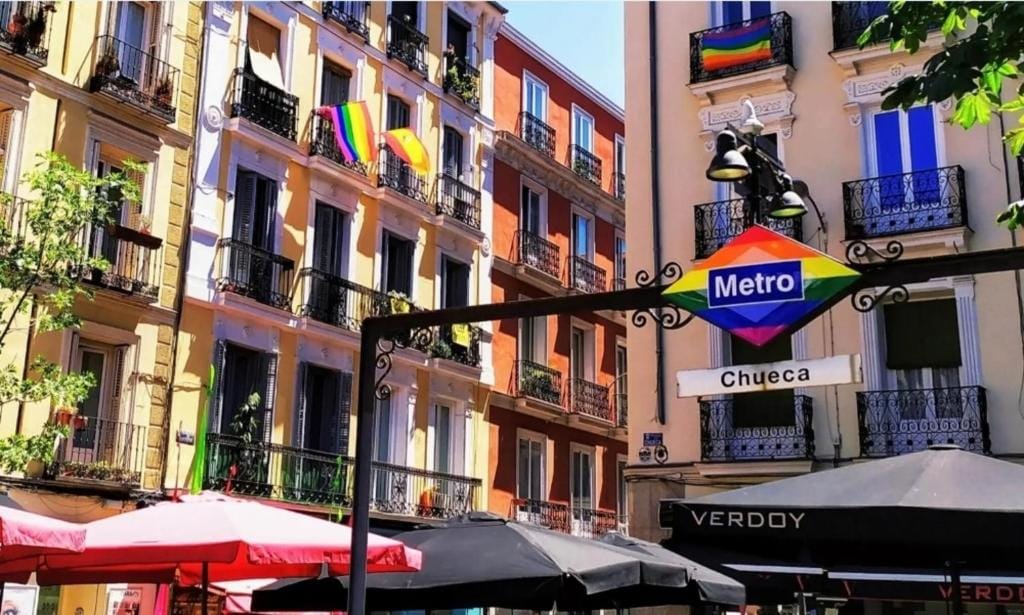
Plaza de Chueca is the heart of the district, a lively square, and nightlife that embodies the spirit of the neighborhood. It's surrounded by cafes, bars, and restaurants that are busy with activity throughout the day and night. The plaza is a popular meeting spot during Madrid’s annual Pride celebrations and hosts various events and performances.
Calle Hortaleza
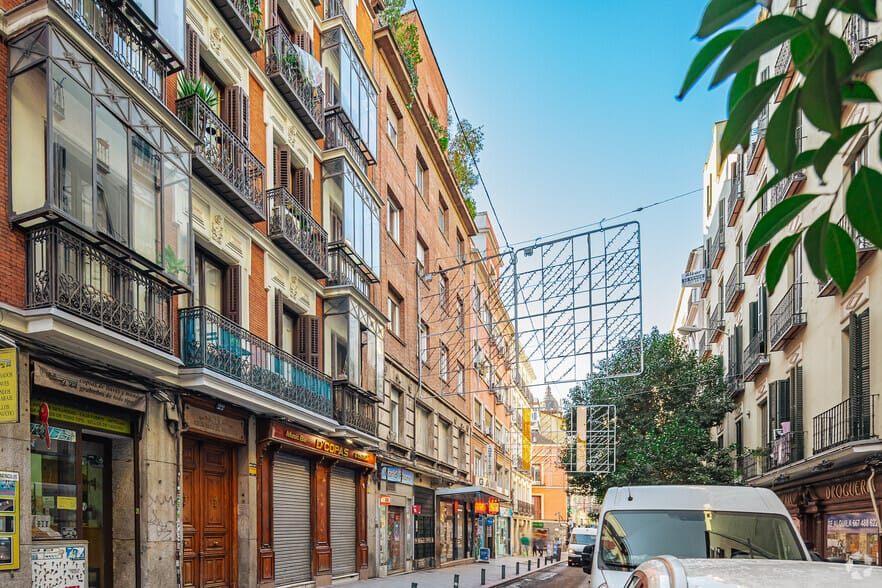
Calle Hortaleza is one of the main shopping streets in Chueca. It features a mix of international brands and local boutiques, offering everything from fashion and accessories to unique gifts. The street also has numerous beauty salons and lifestyle shops catering to diverse tastes and preferences.
Justicia

Justicia, part of Chueca, is known for its fashionable boutiques and upscale dining, blending chic lifestyle with vibrant nightlife.
Chueca District Highlights
- Vibe: Vibrant, inclusive, fashionable
- Good for: Nightlife, shopping, dining
- Accommodation: Stylish boutique hotels and modern apartments
Pros and Cons Staying In Madrid's Chueca District
The Chueca District in Madrid is celebrated for its vibrant atmosphere and inclusive culture, particularly popular within the LGBTQ+ community. Here's a focused look at the pros and cons for visitors contemplating a stay in this lively district:
Pros:
- Inclusive and Welcoming Atmosphere: Chueca is known for its open and accepting environment, making it a favorite among LGBTQ+ travelers and anyone looking for a friendly and inclusive place to stay.
- Central Location: Situated right in the heart of Madrid, Chueca offers easy access to other parts of the city, including nearby districts like Gran Vía and Malasaña, enhancing its appeal for tourists.
- Vibrant Nightlife: The district boasts a lively nightlife scene with a plethora of bars, clubs, and cafes that stay active till late, providing endless entertainment options.
- Cultural Diversity: Chueca is rich in cultural diversity, hosting numerous cultural events, art exhibitions, and the annual Madrid Pride, one of the biggest pride festivals in Europe.
- Boutique Shopping: The area features unique boutiques and designer stores, offering visitors a distinctive shopping experience away from the mainstream retail outlets.
- Culinary Delights: With an array of restaurants and tapas bars, Chueca offers a taste of both traditional Spanish and international cuisines, catering to a variety of palates.
Cons:
- Noise Levels: Due to its vibrant nightlife and bustling streets, Chueca can be quite noisy, especially during the evening and on weekends, which might be a drawback for those seeking peace and quiet.
- Crowded: The district’s popularity, especially during events like Pride, can lead to overcrowded streets and venues, which may detract from the enjoyment for some visitors.
- Higher Prices in Some Areas: Being a trendy and central area, some parts of Chueca can be relatively expensive in terms of dining and accommodation compared to quieter, less central neighborhoods.
- Limited Green Spaces: Like many inner-city areas, Chueca has limited access to large green spaces, which might be a downside for visitors looking to relax in more natural settings within the vicinity.
- Occasional Over-commercialization: Some visitors might find parts of Chueca to be overly commercialized, particularly the main thoroughfares, which can take away from the authentic local experience.
Chueca offers a dynamic and exciting urban experience, marked by its welcoming community and central location. While the area is perfect for those who enjoy nightlife and cultural diversity, the noise and crowds could be a downside for those looking for a more relaxed stay.
Attractions Near Chueca District
- Gran Vía: Just a few minutes' walk from Chueca, Gran Vía is Madrid’s bustling main street, famous for its spectacular architecture, theaters, shopping, and nightlife.
- Plaza de Chueca: The central square of Chueca is a lively hub of activity, surrounded by numerous bars, cafes, and shops that reflect the neighborhood's dynamic and inclusive culture.
- Mercado de San Antón: A modern market offering a variety of gourmet foods and a rooftop terrace that serves as a restaurant, popular for its views and ambiance.
- Museo Nacional de Romanticismo: Close to Chueca, this museum offers a glimpse into 19th-century Spanish life and romanticism through art, furniture, and decor.
- Plaza del Dos de Mayo: Located in nearby Malasaña, this historic square is a center for leisure and social gatherings, surrounded by bars and cafes with a youthful vibe.
- Museo de Historia de Madrid: Also close to Chueca, this museum details the history of Madrid through various artifacts, paintings, and models, located in a beautifully restored baroque building.
- Plaza de Cibeles and Palacio de Cibeles: A short walk from Chueca, this iconic square features the stunning Cybele Palace (now City Hall) and a famous fountain, both symbols of the city.
- Calle Fuencarral: A major shopping street that forms the border between Chueca and Malasaña, known for its fashion stores ranging from international brands to independent boutiques.
- Calle Hortaleza: Another significant street within Chueca, offering a mix of traditional and modern shopping experiences, as well as numerous dining options.
Chamberí District

Chamberí offers a glimpse into traditional Madrid life with its classic architecture and quieter, more residential atmosphere. Chamberi has an amazing selection of dining options, including restaurants boasting 2 and 3 Michelin stars.
Best for: Families, students, and long-term visitors.
Best Neighborhoods In Madrid's Chamberí District To Stay In
Almagro

Almagro in Chamberí is noted for its elegant buildings and cultural institutions, offering a sophisticated yet tranquil city experience.
Ríos Rosas

Ríos Rosas features a mix of educational institutions and residential areas, ideal for those looking for a local experience with access to green spaces like the Santander Park.
Chamberí District Highlights
- Vibe: Authentic, quiet, residential
- Good for: Cultural immersion, family living
- Accommodation: Comfortable apartments and mid-range hotels
Pros and Cons Staying In Madrid's Chamberí District
The Chamberí District in Madrid is known for its authentic Madrid atmosphere, combining the peace one would experience in a calm residential neighborhood. This district offers a glimpse into everyday Madrid life, away from the typical tourist paths. Here are the pros and cons for visitors considering staying in Chamberí:
Pros:
- Authentic Local Experience: Chamberí is less touristy compared to other central areas like Centro or Salamanca, offering visitors a chance to experience the city as locals do.
- Cultural Attractions: The district is home to several small museums, theaters, and cultural centers such as the Sorolla Museum, dedicated to the famous Spanish painter Joaquín Sorolla, and the Teatros del Canal, which hosts a variety of live performances.
- Quiet, Residential Atmosphere: Chamberí provides a peaceful environment, with tree-lined streets and traditional architecture, making it ideal for those seeking a quieter stay.
- Excellent Dining Options: The area boasts a variety of restaurants serving traditional Spanish cuisine as well as international dishes, providing a more authentic dining experience at generally lower prices than in the tourist-heavy areas.
- Good Public Transport Links: Chamberí is well connected by Madrid’s metro system, making it easy to access the rest of the city while enjoying a stay in a less crowded neighborhood.
Cons:
- Fewer Tourist Attractions: Compared to districts like Centro or Retiro, Chamberí has fewer conventional tourist attractions, which might be a drawback since most of Madrid’s most famous sites will not be within walking distance.
- Nightlife: While there are some bars and clubs, Chamberí lacks a nigh life scene, areas like Chueca or Malasaña would be better suited for visitors looking to indulge in drinks and socializing. This could be a con for those seeking lively night entertainment.
- Shopping Options: The shopping options in Chamberí are more limited in terms of large retail stores or specialty shops found in more commercial districts.
- Limited Language Services: In this less tourist-centric area, visitors might find fewer services available in English or other languages outside of Spanish, which could be challenging for those not familiar with the Spanish language.
- Pace of Life: The slower, more relaxed pace of life in Chamberí won't appeal to visitors who prefer to people watch while visiting new places.
Chamberí is perfect for those looking to immerse themselves in a genuine Madrid neighborhood, offering a tranquil retreat with plenty of local charm. However, its quieter nature and fewer tourist facilities might require visitors to adjust expectations and plan for more travel within the city to reach major sights and shopping areas.
Attractions Near Chamberí District
Museo Sorolla: Located in Chamberí itself, this museum is dedicated to the works of Spanish impressionist Joaquín Sorolla, featuring his paintings and personal belongings. The building was once his residence and includes a beautiful garden designed by the artist.
Teatros del Canal: Situated in the southern part of Chamberí, this modern performing arts venue offers a range of performances, from theater to opera and dance, and is a hub of cultural activity in Madrid.
Plaza de Olavide: A popular public square in the heart of Chamberí, known for its lively atmosphere, outdoor cafes, and pleasant surroundings, perfect for a relaxing afternoon among locals.
Museo Geominero: Located in the northern part of Chamberí, this museum showcases an extensive collection of minerals, fossils, and rocks from Spain and around the world, housed in an impressive historic building.
Andén 0 (Chamberí Station): A former metro station in Chamberí, now a museum dedicated to Madrid’s metro system, preserving its early 20th-century architecture and offering a fascinating glimpse into the city's transit history.
Museo de la Historia de Madrid: Just southeast of Chamberí, this museum explores the rich history of Madrid, focusing on the city’s development from the 16th century onward, with detailed exhibits and artifacts.
Cuartel del Conde-Duque: A short walk south of Chamberí, this cultural center hosts various exhibitions, concerts, and events throughout the year, housed in a striking historical building that was once a military barracks.
Parque de Santander: A large park on the western edge of Chamberí, offering sports facilities, walking paths, and plenty of green space for relaxation, popular among both locals and visitors.
Retiro District

Retiro is named after the famous Retiro Park, known as Parque del Buen Retiro, and the park stands as one of Madrid's largest and most beloved public parks. Covering over 125 hectares (approximately 350 acres) in the heart of the city offering lush landscapes and a quieter pace, dotted with museums and cultural landmarks.
Best for: Art aficionados, families, and those seeking relaxation.
Best Neighborhoods In Madrid's Retiro District To Stay In
Ibiza

Ibiza is a neighborhood known for its relaxed lifestyle and the high quality of its services and amenities. Located just east of Retiro Park, it's particularly popular with families and older residents due to its tranquil streets and the abundance of cafes, and restaurants. The area also benefits from excellent schools and medical facilities, making it a desirable residential area.
Jerónimos
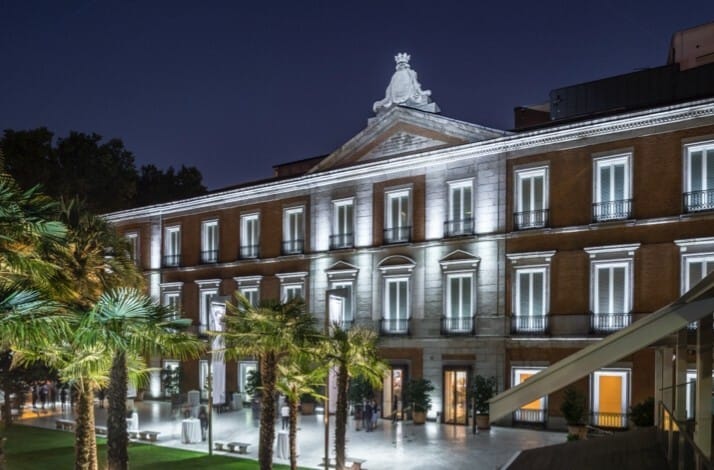
Jerónimos is one of the most prestigious and wealthy neighborhoods in Madrid. It is located directly adjacent to the Prado Museum and close to other key cultural institutions such as the Reina Sofía Museum and the Thyssen-Bornemisza Museum. The area is characterized by its elegant, historical buildings and tree-lined streets.
Retiro District Highlights
- Vibe: Peaceful, cultural, green
- Good for: Museum visits, outdoor activities
- Accommodation: High-end residential apartments and luxury hotels
Pros and Cons Staying In Madrid's Retiro District
Retiro offers a blend of cultural richness and serene living spaces within the bustling city. It’s known for its refined atmosphere and access to some of Madrid’s most beautiful green spaces. Here are the pros and cons for visitors considering staying in the Retiro District:
Pros:
- Proximity to Retiro Park: The district is adjacent to Retiro Park, Madrid’s most famous and beloved park, offering vast green spaces, scenic walks, and recreational activities, making it ideal for nature lovers and those seeking outdoor activities.
- Cultural Attractions: Retiro is close to Madrid’s renowned "Golden Triangle of Art," which includes the Prado Museum, the Reina Sofia Museum, and the Thyssen-Bornemisza Museum, allowing easy access to some of the world’s most prestigious art collections.
- Peaceful Residential Areas: Known for its tranquil residential neighborhoods, Retiro offers a quiet escape from the busier tourist hubs of the city, which can be particularly appealing for families or those seeking a relaxed atmosphere.
- Excellent Dining and Shopping: The area around Retiro is dotted with a variety of upscale restaurants and boutique shops, providing quality dining and shopping experiences without the excessive crowds of more central districts.
- Well-Connected by Public Transport: Retiro enjoys excellent public transport connections, including metro and bus services, making it easy to navigate to other parts of Madrid.
Cons:
- Higher Accommodation Costs: Due to its desirable location and upscale environment, accommodation in Retiro can be quite expensive compared to other districts.
- Less Nightlife: The district is not known for a vibrant nightlife compared to areas like Chueca or Malasaña, with fewer bars and clubs, which might be a downside for those seeking evening entertainment.
- Fewer Budget Dining Options: While there are plenty of dining options, budget-friendly eateries are less common, which might be a consideration for visitors looking to keep costs down.
- Quiet at Night: The tranquil atmosphere of Retiro extends into the evenings, which might not appeal to those looking for the lively night scenes found in other parts of the city.
- Tourist Density Near Attractions: The areas close to major museums and the park can get crowded, especially on weekends and holidays, which might detract from the peaceful charm of the district.
Retiro offers a sophisticated, cultured experience with the bonus of a beautiful park and top museums nearby. It’s perfect for those who appreciate a quieter, more refined base with easy access to both nature and culture. However, the quieter nightlife might not suit everyone, particularly younger travelers or those on a tighter budget.
Attractions Nera Retiro District
Parque del Buen Retiro (Retiro Park): The central highlight of the district, this expansive park offers beautiful gardens, lakes, sculptures, and plenty of space for walking, boating, and relaxing. It's one of Madrid's most iconic green spaces.
Palacio de Cristal: Located within Retiro Park, this stunning glass structure was built in 1887 and hosts contemporary art exhibitions under the management of the Reina Sofía Museum.
Palacio de Velázquez: Also found in Retiro Park, this elegant building is another venue for temporary art exhibitions, featuring both national and international artists.
Real Jardín Botánico (Royal Botanical Garden): Located near the Prado Museum, this historic botanical garden is home to a vast collection of plants from around the world, offering a peaceful retreat amidst the bustling city.
Museo Nacional del Prado: Situated just west of the Retiro district, this world-famous museum houses a remarkable collection of European art, featuring masterpieces by artists such as Velázquez, Goya, and Bosch.
Puerta de Alcalá: A monumental gate located at the northwest corner of Retiro Park, this iconic structure is a symbol of Madrid and a stunning example of neoclassical architecture.
Calle de O'Donnell: A major shopping street bordering Retiro Park, known for its mix of high-end boutiques, local shops, and restaurants, perfect for a leisurely stroll after visiting the park.
Calle de Menéndez Pelayo: This lively avenue runs along the eastern edge of Retiro Park and is lined with cafes, tapas bars, and shops, offering a vibrant atmosphere close to the green space.
Frequently Asked Questions
What is the best area to stay in Madrid for first-time visitors?
For first-time visitors, Centro is the best area to stay. It’s in the heart of Madrid, offering easy access to top attractions like the Royal Palace, Plaza Mayor, and Puerta del Sol, along with an abundance of restaurants and nightlife.
What neighborhood is the best for nightlife in Madrid?
Absolutely, here’s a more organized bullet-point format of your answer for the blog question about the best areas in Madrid for nightlife:
What area of Madrid has the best nightlife?
Madrid's nightlife is diverse, with several areas known for their lively bar and club scenes. Here are the top three areas for nightlife:
- Huertas:
- Popularity: Highly favored among tourists and foreign students.
- Main Streets: Nightlife is concentrated along Calle Huertas and its parallel streets.
- Highlights: Known for its dynamic atmosphere with a wide selection of bars and clubs.
- Location: Very close to Puerta del Sol, adding to its accessibility and appeal.
- Chueca:
- Community: Particularly popular in the LGBTQ+ community, known for its inclusive and trendy vibe.
- Offerings: Features a diverse array of bars, clubs, and late-night spots.
- Atmosphere: Trendy bars and vibrant clubs make it a top choice for a fashionable night out.
- Malasaña:
- Culture: Best known for its bohemian and hipster atmosphere.
- Scene: Offers indie bars and alternative nightspots.
- Vibe: The area exudes a laid-back, artistic feel with venues that attract a creative crowd.
These are the hotspots for nightlife in Madrid, each offering unique experiences that cater to different tastes and styles.
Which area in Madrid is best for shopping?
Gran Vía is Madrid's main shopping district, offering everything from high-street fashion to luxury brands. Salamanca is another great area for high-end boutiques and designer stores.
What’s the best area to stay in Madrid for budget travelers?
For budget travelers, Lavapiés, Argüelles, and Chamberí are ideal areas. These neighborhoods offer more affordable accommodations and dining options while still being close to major attractions.
Is Madrid a safe city for tourist?
Madrid generally has a lower crime rate compared to many other major European cities, making it a relatively safe destination for tourists and residents alike. Here’s a breakdown of how Madrid's safety compares to other European cities:
- Violent Crime: Madrid has a relatively low rate of violent crimes such as assault and armed robbery, especially when compared to cities like London or Paris. The presence of police in tourist areas and major neighborhoods enhances this safety.
- Petty Crime: Like many tourist-centric cities, Madrid experiences its share of petty crimes, including pickpocketing and purse snatching, particularly in crowded areas like Puerta del Sol, Gran Vía, and the metro system. However, these are more nuisances than threats to personal safety, and taking standard precautions can greatly reduce the risk.
- Overall Safety: Statistically, Madrid offers a high level of overall safety. It ranks well in European safety indexes, often scoring better in terms of personal security than cities such as Rome or Barcelona, which struggle more significantly with petty theft and scams targeting tourists.
This brings an end to our In-depth Guide: Where to Stay in Madrid
Whether you’re seeking art and culture, lively nightlife, or peaceful green spaces, Madrid has it all. Find your ideal base to fully enjoy the this beautiful city, and all it has to offer.
See More Madrid Travel Resources
